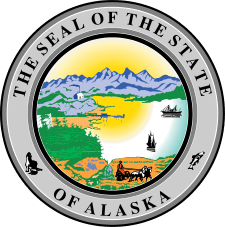Government of Alaska
The government of Alaska in common with state and federal governments of the United States, has three branches of government: the executive, consisting of the Governor of Alaska and the state agencies; the state legislature consisting of two chambers, the House of Representatives and the Senate; and the judiciary consisting of the Supreme court and lower courts.
Alaska has 246 federally recognized tribal governments and one federal Indian (Native American) reservation.[1]
Executive
The Governor of Alaska is the senior-most official of the Alaska executive branch. The main Alaska state agencies are the:
- Alaska Court System
- Department of Administration
- Department of Commerce, Community and Economic Development
- Department of Corrections
- Department of Education and Early Development
- Department of Environmental Conservation
- Department of Fish and Game
- Department of Health and Social Services
- Department of Labor and Workforce Development
- Department of Law
- Department of Military and Veteran Affairs
- Department of Natural Resources
- Department of Public Safety
- Department of Revenue
- Department of Transportation and Public Facilities
Other agencies are the:
- Alaska Division of Juvenile Justice
- Alaska Permanent Fund
- Alaska Volcano Observatory
- Alaska Oil and Gas Conservation Commission
- Alaska State Pension Investment Board
Legislature
Alaska has a Legislature. It is a bicameral institution, consisting of a lower chamber, the Alaska House of Representatives with 40 members, and an upper chamber, the Alaska Senate with 20 members. There are 40 House Districts (1-40) and 20 Senate Districts (A-T). [2] The Alaska Legislature meets in the State Capitol building in Juneau.
Judiciary
The Alaska Court System is the unified, centrally administered, and totally state-funded judicial system. The Alaska District Court are the primary misdemeanor trial courts, the Alaska Superior Courts are the primary felony trial courts, and the Alaska Supreme Court and the Alaska Court of Appeals are the primary appellate courts. The Chief Justice of the Alaska Supreme Court is the administrative head of the Alaska Court System.
Local government
Alaska is divided into 16 boroughs (including unified municipalities),[1] as opposed to "counties." The function is the same, but whereas some states use a three-tiered system of decentralization — state/county/township — most of Alaska only uses two tiers — state/borough. Owing to the state's low population density, most of the land is located in the Unorganized Borough which, as the name implies, has no intermediate borough government of its own, but is administered directly by the state government. Currently (2000 census) 57.71 percent of Alaska's land area has this status; however, its population comprises only 13.05 percent of the state's total. For statistical purposes the United States Census Bureau divides this territory into census areas. Anchorage merged the city government with the Greater Anchorage Area Borough in 1971 to form the Municipality of Anchorage, containing the city proper, and the bedroom communities of Eagle River, Chugiak, Peters Creek, Girdwood, Bird, and Indian. Fairbanks, on the other hand, has a separate borough (the Fairbanks North Star Borough) and municipality (the City of Fairbanks).
See also
References
- 1 2 University of Alaska Justice Center local & borough government
- ↑
